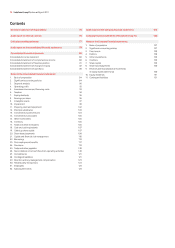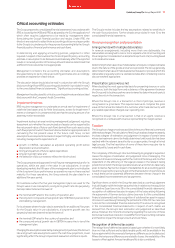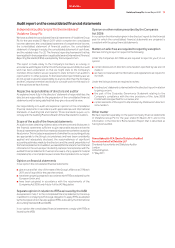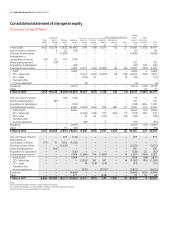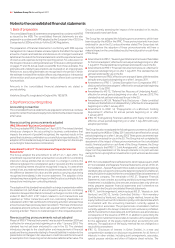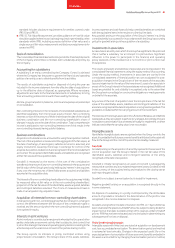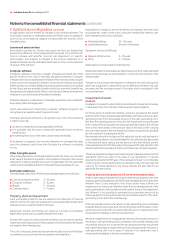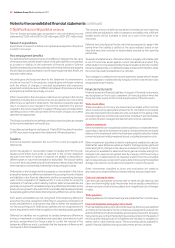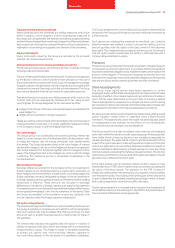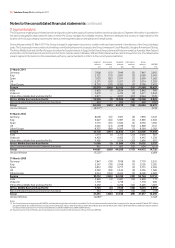Vodafone 2011 Annual Report Download - page 86
Download and view the complete annual report
Please find page 86 of the 2011 Vodafone annual report below. You can navigate through the pages in the report by either clicking on the pages listed below, or by using the keyword search tool below to find specific information within the annual report.84 Vodafone Group Plc Annual Report 2011
Notes to the consolidated nancial statements
1. Basis of preparation
The consolidated financial statements are prepared in accordance with IFRS
as issued by the IASB. The consolidated financial statements are also
prepared in accordance with IFRS adopted by the European Union (‘EU’), the
Companies Act 2006 and Article 4 of the EU IAS Regulations.
The preparation of financial statements in conformity with IFRS requires
management to make estimates and assumptions that affect the reported
amounts of assets and liabilities and disclosure of contingent assets and
liabilities at the date of the financial statements and the reported amounts
of revenue and expenses during the reporting period. For a discussion on
the Group’s critical accounting estimates see “Critical accounting estimates”
on pages 77 and 78. Actual results could differ from those estimates. The
estimates and underlying assumptions are reviewed on an ongoing basis.
Revisions to accounting estimates are recognised in the period in which
the estimate is revised if the revision affects only that period or in the period
of the revision and future periods if the revision affects both current and
future periods.
Amounts in the consolidated financial statements are stated in
pounds sterling.
Vodafone Group Plc is registered in England (No. 1833679).
2. Signicant accounting policies
Accounting convention
The consolidated financial statements are prepared on a historical cost basis
except for certain financial and equity instruments that have been measured
at fair value.
New accounting pronouncements adopted
IFRS 3 (Revised) “Business Combinations”
The Group adopted IFRS 3 (Revised) on 1 April 2010. The revised standard
introduces changes in the accounting for business combinations that
impacts the amount of goodwill recognised, the reported results in the
period that a business combination occurs and future reported results. The
adoption of this standard is likely to have a significant impact on the Group’s
accounting for future business combinations.
Amendment to IAS 27 “Consolidated and Separate Financial
Statements”
The Group adopted the amendment to IAS 27 on 1 April 2010. The
amendment requires that when a transaction occurs with non-controlling
interests in Group entities that do not result in a change in control, the
difference between the consideration paid or received and the recorded
non-controlling interest should be recognised in equity. In cases where
control is lost, any retained interest should be remeasured to fair value with
the difference between fair value and the previous carrying value being
recognised immediately in the income statement. The adoption of this
standard may have a significant impact on the Group’s accounting for future
transactions involving non-controlling interests.
The adoption of this standard has resulted in a change in presentation within
the statement of cash flows of amounts paid to acquire non-controlling
interests in Group entities that do not result in a change in control. In the year
ended 31 March 2011 £137 million related to such transactions was
classified as “Other transactions with non-controlling shareholders in
subsidiaries” within “Net cash flows from financing activities”, whereas these
amounts would have previously been recorded in “Purchase of interests in
subsidiaries and joint ventures, net of cash acquired” within “Cash flows from
investing activities”. There is no material impact in the comparative period.
New accounting pronouncements not yet adopted
Phase I of IFRS 9 “Financial Instruments” was issued in November 2009 and
is effective for annual periods beginning on or after 1 January 2013. This
standard has not yet been endorsed for use in the EU. The standard
introduces changes to the classification and measurement of financial
assets and the requirements relating to financial liabilities in relation to the
presentation of changes in fair value due to credit risks and the removal of
an exemption from measuring certain derivative liabilities at fair value. The
Group is currently assessing the impact of the standard on its results,
financial position and cash flows.
The Group has not adopted the following pronouncements, which have
been issued by the IASB or the IFRIC. These pronouncements have been
endorsed for use in the EU, unless otherwise stated. The Group does not
currently believe the adoption of these pronouncements will have a
material impact on the consolidated results, financial position or cash flows
of the Group.
■ Amendments to IFRS 1, “Severe hyperinflation and removal of fixed dates
for first-timer adopters”, effective for annual periods beginning on or after
1 July 2011. This standard has not yet been endorsed for use in the EU.
■ Amendments to IFRS 7, “Financial Instruments: Disclosure”, effective for
annual periods beginning on or after 1 July 2011. This standard has not
yet been endorsed for use in the EU.
■ “Improvements to IFRSs”, effective over a range of dates, with the earliest
being for annual periods beginning on or after 1 January 2011.
■ Amendment to IFRS 1, “Limited Exemption from Comparative IFRS 7
disclosures for first time adopters”, effective for annual periods beginning
on or after 1 July 2010.
■ Amendment to IAS 12, “Deferred tax: Recovery of Underlying Assets”,
effective for annual periods beginning on or after 1 January 2012. This
standard has not yet been endorsed for use in the EU.
■Amendment to IAS 24, “Related Party Disclosures – State-controlled
Entities and the Definition of a Related Party”, effective for annual periods
beginning on or after 1 January 2011.
■ Amendment to IFRIC 14, “Prepayments on a Minimum Funding
Requirement”, effective for annual periods beginning on or after
1 January 2011.
■ IFRIC 19, “Extinguishing Financial Liabilities with Equity Instruments”,
effective annual periods beginning on or after 1 July 2010 with early
adoption permitted.
The Group has also not adopted the following pronouncements, all of which
were issued by the IASB on 12 May 2011 and which are effective for annual
periods beginning on or after 1 January 2013. These pronouncements have
not yet been endorsed for use in the EU. The Group has not completed its
assessment of the impact of these pronouncements on the consolidated
results, financial position or cash flows of the Group. However, the Group
currently expects that IFRS 11, “Joint Arrangements”, will have a material
impact on the presentation of the Group’s interests in its joint ventures
owing to the Group’s significant investments in joint ventures as discussed
in note 13.
■IFRS 10, ‘Consolidated Financial Statements’, which replaces parts of IAS
27, ‘Consolidated and Separate Financial Statements and all of SIC-12,
‘Consolidation – Special Purpose Entities’, builds on existing principles by
identifying the concept of control as the determining factor in whether an
entity should be included within the consolidated financial statements of
the parent company. The remainder of IAS 27, ‘Separate Financial
Statements’, now contains accounting and disclosure requirements for
investments in subsidiaries, joint ventures and associates only when an
entity prepares separate financial statements and is therefore not
applicable in the Group’s consolidated financial statements.
■IFRS 11, ‘Joint Arrangements’, which replaces IAS 31, ‘Interests in Joint
Ventures’ and SIC-13, ‘Jointly Controlled Entities – Non-monetary
Contributions by Venturers’, requires a single method, known as the
equity method, to account for interests in jointly controlled entities which
is consistent with the accounting treatment currently applied to
investments in associates. The proportionate consolidation method
currently applied to the Group’s interests in joint ventures is prohibited.
IAS 28, ‘Investments in Associates and Joint Ventures’, was amended as a
consequence of the issuance of IFRS 11. In addition to prescribing the
accounting for investment in associates, it now sets out the requirements
for the application of the equity method when accounting for joint
ventures. The application of the equity method has not changed as a
result of this amendment.
■IFRS 12, ‘Disclosure of Interest in Other Entities’, is a new and
comprehensive standard on disclosure requirements for all forms of
interests in other entities, including joint arrangements, associates,
special purpose vehicles and other off balance sheet vehicles. The


